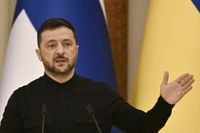On the night of September 14, 2025, the distant thunder of war echoed nearly 500 miles inside Russian territory, as Ukrainian drones struck the massive Kirishi oil refinery in Russia’s St. Petersburg region. The attack, confirmed by Ukraine’s Armed Forces General Staff and reported widely by outlets including Reuters, marked a significant escalation in Kyiv’s campaign to choke off the oil revenues and fuel supplies sustaining Moscow’s war machine.
The Kirishi refinery, a sprawling facility owned by Surgutneftegaz, processes over 17 million tons of oil annually—about 6.4% of Russia’s total output, or 355,000 barrels per day. According to industry sources cited by Reuters, the Ukrainian strike shut down a key processing unit responsible for nearly 40% of the plant’s capacity. The damage was so severe that repairs are expected to take at least a month, if not longer.
Russia’s air defense forces reportedly intercepted three drones in the vicinity, but the wreckage from one crashed onto the refinery site, igniting a fire. Leningrad Oblast Governor Alexander Drozdenko assured the public that the blaze was extinguished and, remarkably, there were no human casualties. Yet the economic and strategic consequences were already rippling far beyond the refinery’s perimeter.
This wasn’t the first time Kirishi had found itself in the crosshairs. Ukraine’s military intelligence agency (HUR) had previously targeted the plant in March, underscoring a pattern of attacks that’s grown more frequent and audacious. Just two days before the Kirishi strike, on September 12, Ukrainian drones hit Primorsk—Russia’s largest oil-loading port on the Baltic Sea—causing fires aboard an oil tanker and at a pumping station, and forcing the facility to suspend all shipments. According to the Ukrainian Security Service (SBU), these attacks are part of a deliberate strategy to disrupt Russia’s oil sector, which they argue is both the financial and logistical backbone of President Vladimir Putin’s war effort.
Kyiv’s rationale is blunt. As one Polish defense industry director told the National Security Journal, “As long as Russian President Vladimir Putin is able to extract and sell oil, or refine it and sell the petrol produced, this war is never going to end.” Ukraine’s leadership, echoed by President Volodymyr Zelenskyy during a September 17 briefing with European Parliament President Roberta Metsola in Kyiv, insists that “Putin must feel that his intention to continue the war… will mean pain for Russia. If Russia does not feel pain, it fights.”
Indeed, the pain is becoming visible in Russia’s hinterlands. The spate of attacks over the past year has forced shutdowns at multiple oil facilities, triggering fuel shortages, rationing, and long queues at petrol stations across the country. While Moscow decries these strikes as attacks on civilian infrastructure, Kyiv maintains that refineries and ports are legitimate military targets, as they fund and fuel the ongoing invasion.
The fallout from these attacks is not confined to the battlefield. The European Union, which has already imposed 18 rounds of sanctions on Russia since the 2022 invasion, is preparing a 19th package aimed squarely at Russian energy resources and the infrastructure of their trade. Zelenskyy emphasized that the new sanctions should also target the Russian banking sector and the various evasion schemes used to finance the war. “We also count on corresponding sanction steps from the United States,” he added, signaling a transatlantic push to ratchet up the pressure.
Yet, achieving unity within Europe remains a challenge. Countries like Slovakia and Hungary still depend on Russian energy, and Hungary, bolstered by support from US President Donald Trump, has recently obstructed the automatic extension of EU sanctions. According to media reports, the European Commission delayed announcing the 19th package to coordinate with the G7 and align strategies for reducing dependency on Russian oil—a move that underscores the complicated dance of diplomacy and economic interests at play.
Meanwhile, the war’s technological front is advancing rapidly. The Kirishi strike demonstrated not only the increasing range of Ukrainian drones but also their growing precision. These developments have alarmed Russia’s neighbors. Poland, for instance, has seen around 20 military drone incursions into its airspace in the past week—a trend Warsaw calls a deliberate Russian provocation. As a result, Polish air defenses are on high alert, and the country has called on other EU states to stop buying Russian energy by the end of 2026, offering help to ease the transition.
Across Europe, the response is hardening. Denmark recently announced it would acquire long-range precision weapons for the first time, including missiles and drones capable of striking enemy territory, in what Prime Minister Mette Frederiksen called “a paradigm shift in Danish defense policy.” The country also committed €7.8 billion to European-made air defense systems—the largest arms purchase in its history. Germany, too, has stepped up. Chancellor Friedrich Merz warned that Putin “has been testing the limits for a long time,” referencing recent airspace violations and calling for greater deterrence and allied unity. German Defense Minister Boris Pistorius noted that Germany has now surpassed the US as Ukraine’s largest military aid provider.
On the ground in Ukraine, the first US military aid purchased by Ukraine’s allies under the Prioritized Ukraine Requirements List (PURL) mechanism has started arriving, including missiles for Patriot and HIMARS systems. President Zelenskyy announced that Ukraine has received over $2 billion from partners for PURL, with another $3.5 to $3.6 billion expected in October. These funds, bolstered by a $150 million joint investment fund with the US International Development Finance Corporation, are earmarked for energy, infrastructure, and critical minerals projects vital to Ukraine’s reconstruction and resilience.
Yet, the shadow of war—and the specter of escalation—looms large. UN Secretary-General Antonio Guterres has warned that peace in Ukraine is not on the horizon. Demonstrations have erupted in Slovakia over the government’s pro-Russian stance, and the Baltic states remain vigilant, with Latvia arresting a man accused of spying for Moscow. Even as European Parliament President Metsola pledged that “Ukraine would never walk alone,” the continent braces for a conflict that shows few signs of abating.
For now, the fires at Kirishi and Primorsk are more than just smoldering ruins; they are visible symbols of a new phase in the war—one where economic pain, technological innovation, and international resolve are set against the stubborn realities of geography and politics. As Ukraine’s drones fly deeper into Russian territory and Western sanctions bite harder, the question is not if Russia will feel the pain, but how—and whether that pain will be enough to bring the war closer to its end.


